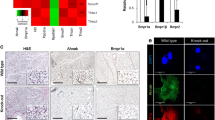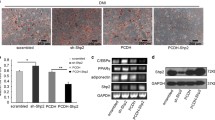Abstract
Angiotensin II reduces adipogenic differentiation of preadipose cells present in the stroma-vascular fraction of human adipose tissue, which also includes several cell types. Because of the ability of non-adipose lineage cells in the stroma-vascular fraction to respond to angiotensin II, it is not possible to unequivocally ascribe the anti-adipogenic response to a direct effect of this hormone on preadipose cells. Therefore, we used the human Simpson–Golabi–Behmel syndrome (SGBS) preadipocyte cell strain to investigate the consequences of angiotensin II treatment on adipogenic differentiation under serum-free conditions, by assessing expression of typical adipocyte markers perilipin and fatty acid-binding protein 4 (FABP4), at the transcript and protein level. Reverse transcription-polymerase chain reaction showed that perilipin and FABP4 transcripts were, respectively, reduced to 0.33 ± 0.07 (P < 0.05) and 0.41 ± 0.19-fold (P < 0.05) in SGBS cells induced to adipogenic differentiation in the presence of angiotensin II. Western Blot analysis corroborated reduction of the corresponding proteins to 0.23 ± 0.21 (P < 0.01) and 0.46 ± 0.30-fold (P < 0.01) the respective controls without angiotensin II. Angiotensin II also impaired morphological changes associated with early adipogenesis. Hence, we demonstrated that angiotensin II is able to directly reduce adipogenic differentiation of SGBS preadipose cells.






Similar content being viewed by others
References
Paul M, Meher AP, Kreutz R (2006) Physiology of local renin-angiotensin systems. Physiol Rev 86:747–803
Yasue S, Masuzaki H, Okada S et al (2010) Adipose tissue-specific regulation of angiotensinogen in obese humans and mice: impact of nutritional status and adipocyte hypertrophy. Am J Hypertens 23:425–431
Kalupahana NS, Massiéra F, Quignard-Boulange A et al (2012) Overproduction of angiotensinogen from adipose tissue induces adipose inflammation, glucose intolerance, and insulin resistance. Obesity 20:48–56
Putnam K, Shoemaker R, Yiannikouris F, Cassis LA (2012) The renin-angiotensin system: a target of and contributor to dyslipidemias, altered glucose homeostasis, and hypertension of the metabolic syndrome. Am J Physiol Heart Circ Physiol 302:H1219–H1230
Yvan-Charvet L, Massiéra F, Lamandé N et al (2009) Deficiency of angiotensin type 2 receptor rescues obesity but not hypertension induced by overexpression of angiotensinogen in adipose tissue. Endocrinology 150:1421–1428
Massiéra F, Bloch-Faure M, Ceiler D et al (2001) Adipose angiotensinogen is involved in adipose tissue growth and blood pressure regulation. FASEB J 15:2727–2729
Janke J, Engeli S, Gorzelniak K et al (2002) Mature adipocytes inhibit in vitro differentiation of human preadipocytes via angiotensin type 1 receptors. Diabetes 51:1699–1707
Schling P, Mallow H, Trindl A, Loffler G (1999) Evidence for a local renin angiotensin system in primary cultured human preadipocytes. Int J Obes Relat Metab Disord 2:336–341
Schling P, Loffler G (2001) Effects of angiotensin II on adipose conversion and expression of genes of the renin-angiotensin system in human preadipocytes. Horm Metab Res 33:189–195
Brücher R, Cifuentes M, Acuña MJ et al (2007) Larger Anti-adipogenic effect of angiotensin II on omental preadipose cells of obese humans. Obesity 15:1643–1646
Than A, Leow MK, Chen P (2013) Control of adipogenesis by the autocrine interplays between angiotensin 1-7/Mas receptor and angiotensin II/AT1 receptor signaling pathways. J Biol Chem 288:15520–15531
Wilkosz S, Ireland G, Khwaja N et al (2005) A comparative study of the structure of human and murine greater omentum. Anat Embryol 209:251–261
Osborn O, Olefsky JM (2012) The cellular and signaling networks linking the immune system and metabolism in disease. Nat Med 18:363–374
Gray MO, Long CS, Kalinyak JE et al (1998) Angiotensin II stimulates cardiac myocyte hypertrophy via paracrine release of TGF-β1 and endothelin-1 from fibroblasts. Cardiovasc Res 40:352–363
Noh H, Ha H, Yu MR et al (2005) Angiotensin II mediates high glucose-induced TGF-β1 and fibronectin upregulation in HPMC through reactive oxygen species. Perit Dial Int 25:38–47
Kiribayashi K, Masaki T, Naito T et al (2005) Angiotensin II induces fibronectin expression in human peritoneal mesothelial cells via ERK1/2 and p38 MAPK. Kidney Int 67:1126–1135
Bhattacharya I, Ullrich A (2006) Endothelin-1 inhibits adipogenesis: role of phosphorylation of Akt and ERK1/2. FEBS Lett 580:5765–5771
Christancho AG, Lazar MA (2011) Forming functional fat: a growing understanding of adipocyte differentiation. Nat Rev Mol Cell Biol 12:722–733
Fischer-Posovszky P, Newell FS, Wabitsch M, Tornqvist HE (2008) Human SGBS cells—a unique tool for studies of human fat cell biology. Obes Facts 1:184–189
Wabitsch M, Brenner RE, Melzner I et al (2001) Characterization of a human preadipocyte cell strain with high capacity for adipose differentiation. Int J Obes Relat Metab Disord 25:8–15
Dünner N, Quezada C, Berndt FA et al (2013) Angiotensin II signaling in human preadipose cells: participation of ERK1,2-dependent modulation of Akt. PLoS One 8:e75440
Brasaemle DL, Rubin B, Harten I et al (2000) Perilipin A increases triacylglycerol storage by decreasing the rate of triacylglycerol hydrolysis. J Biol Chem 275:38486–38493
Kralisch S, Fasshauer M (2013) Adipocyte fatty acid binding protein: a novel adipokine involved in the pathogenesis of metabolic and vascular disease? Diabetologia 56:10–21
Fuentes P, Acuña MJ, Cifuentes M, Rojas CV (2010) The anti-adipogenic effect of angiotensin II on human preadipose cells involves ERK1,2 activation and PPARγ phosphorylation. J Endocrinol 206:75–83
Chomczynski P, Sacchi N (1987) Single-step method of RNA isolation by acid guanidinium thiocyanate-phenol-chloroform extraction. Anal Biochem 162:156–159
Forcheron F, Legedz L, Chinetti G et al (2005) Genes of cholesterol metabolism in human atheroma: overexpression of perilipin and genes promoting cholesterol storage and repression of ABCA1 expression. Arterioscler Thromb Vasc Biol 25:1711–1717
Arner P, Spalding KLS (2010) Fat cell turnover in humans. Biochem Biophys Res Commun 396:101–104
Tchoukalova YD, Votruba SB, Tchkonia T et al (2010) Regional differences in cellular mechanisms of adipose tissue gain with overfeeding. Proc Natl Acad Sci USA 107:18226–18231
Wang QA, Tao C, Gupta RK, Scherer PE (2013) Tracking adipogenesis during white adipose tissue development, expansion and regeneration. Nat Med 19:1338–1344
Matsushita K, Wu Y, Okamoto Y et al (2006) Local renin angiotensin expression regulates human mesenchymal stem cell differentiation to adipocytes. Hypertension 48:1095–1102
Kim JY, van der Wall E, Laplante M et al (2007) Obesity-associated improvements in metabolic profile through expansion of adipose tissue. J Clin Invest 117:2621–2637
Kusminski CM, Holland WL, Sun K et al (2012) MitoNEET-driven alterations in adipocyte mitochondrial activity reveal a crucial adaptive process that preserves insulin sensitivity in obesity. Nat Med 18:1539–1549
Blüher M, Wilson-Fritch L, Leszyk J et al (2004) Role of insulin action and cell size on protein expression patterns in adipocytes. J Biol Chem 279:31902–31909
Rydén M, Anderson DP, Bergström IB, Arner P (2014) Adipose tissue and metabolic alterations: regional differences in fat cell size and number matter, but differently: a cross-sectional study. J Clin Endocrinol Metab 99:E1870–E1876
Kalupahana NS, Moustaid-Moussa N (2012) The renin-angiotensin system: a link between obesity, inflammation and insulin resistance. Obes Rev 13:136–149
Underwood PC, Adler GK (2013) The renin angiotensin aldosterone system and insulin resistance in humans. Curr Hypertens Rep 15:59–70
Tomono Y, Iwai M, Inaba S et al (2008) Blockade of AT1 receptor improves adipocyte differentiation in atherosclerotic and diabetic models. Am J Hypertens 21:206–212
Acknowledgments
We are grateful to Dr. Miguel Ángel Celis at Luis Tisné Hospital for contributing adipose tissue samples. We also thank Marisol Blanco for technical assistance. This study was funded by a regular grant from CONICYT, FONDECYT (# 1100126).
Author information
Authors and Affiliations
Corresponding author
Ethics declarations
Conflict of interest
The authors declare that they have no conflict of interest.
Ethical approval
All procedures performed in studies involving human participants were in accordance with the ethical standards of the institutional committees at University of Chile and the Metropolitan Health Service, Santiago, Chile, and with the 1964 Helsinki declaration and its later amendments or comparable ethical standards.
Informed consent
Informed consent was obtained from all participants included in the study. This article does not contain any studies with animals performed by any of the authors.
Rights and permissions
About this article
Cite this article
Palominos, M.M., Dünner, N.H., Wabitsch, M. et al. Angiotensin II directly impairs adipogenic differentiation of human preadipose cells. Mol Cell Biochem 408, 115–122 (2015). https://doi.org/10.1007/s11010-015-2487-y
Received:
Accepted:
Published:
Issue Date:
DOI: https://doi.org/10.1007/s11010-015-2487-y




